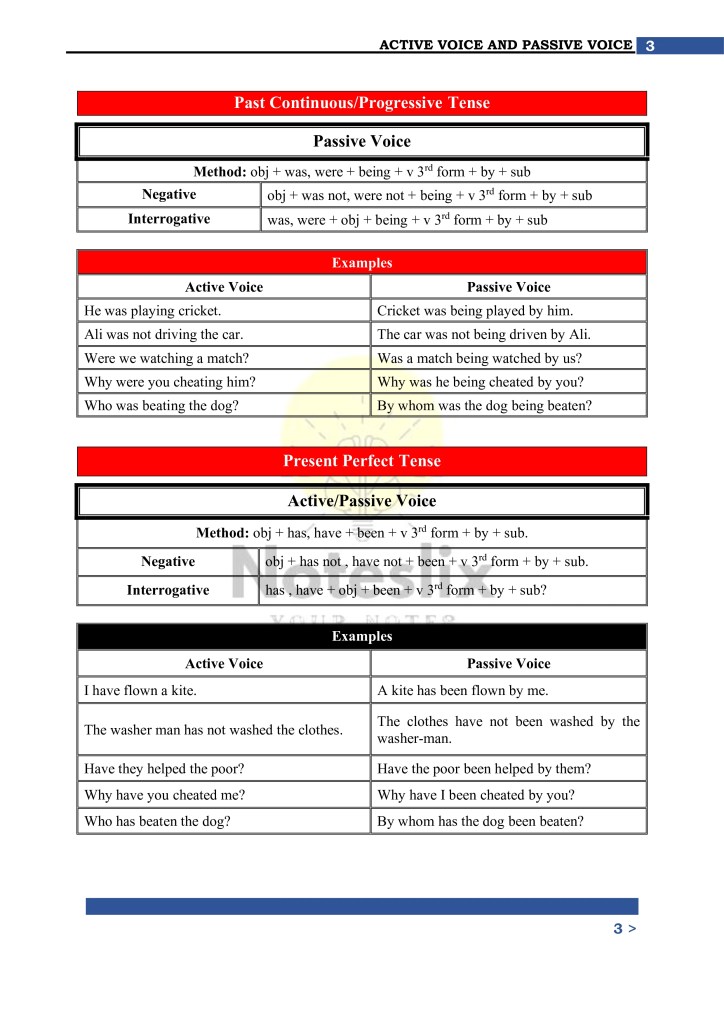Mastering the concepts of active and passive voice is essential for students of English grammar, especially for those in the 9th class.
These concepts enhance sentence structure, clarity, and variety, making communication more effective. 9th Class English Grammar Active Voice and Passive Voice.
Active voice emphasizes the subject performing an action, while passive voice highlights the action’s receiver. In this guide, we’ll explore rules, methods, and examples for different tenses to simplify these grammatical structures.






9th Class English Grammar Active Voice and Passive Voice
Topics Covered in These Notes
The notes provide a comprehensive overview of active and passive voice, focusing on the following key topics:
- Present Indefinite/Simple Tense: Conversion techniques and examples for positive, negative, and interrogative sentences.
- Past Indefinite/Simple Tense: Detailed rules and sentence transformations for various scenarios.
- Future Indefinite/Simple Tense: Explanation of structural changes with practical examples.
- Present Continuous Tense: Methodology and examples for ongoing actions.
- Past Continuous Tense: Guidelines for past actions in progress.
- Perfect Tenses: Insights into present, past, and future perfect tenses with examples.
Rules and Examples
- Present Indefinite Tense
- Rule: Object + is/am/are + V3 + by + subject
- Example:
- Active: She boils eggs.
- Passive: Eggs are boiled by her.
- Past Indefinite Tense
- Rule: Object + was/were + V3 + by + subject
- Example:
- Active: They learned a lesson.
- Passive: A lesson was learned by them.
- Future Indefinite Tense
- Rule: Object + will/shall be + V3 + by + subject
- Example:
- Active: She will wash clothes.
- Passive: Clothes will be washed by her.
- Continuous Tenses
- Present Continuous: Object + is/am/are + being + V3 + by + subject
- Past Continuous: Object + was/were + being + V3 + by + subject
- Examples:
- Active: I am collecting coins.
- Passive: Coins are being collected by me.
- Perfect Tenses
- Rule: Object + has/have/had been + V3 + by + subject
- Examples:
- Active: I have flown a kite.
- Passive: A kite has been flown by me.
Tool for Success in Exams
Understanding active and passive voice is not just about grammar exercises; it’s a vital skill for academic excellence. These notes serve as a tool to:
- Enhance writing clarity.
- Develop precise communication skills.
- Improve performance in exams with well-structured sentences.
Colored Notes
The notes are designed with clear formatting to ensure ease of learning. Key rules, examples, and methods are highlighted using different font styles and colors,
Making it simpler for students to focus on essential details. The use of tables and organized sections further enhances understanding and retention.
Notes Are Free to Use
One of the best features of these notes is their accessibility. Students can freely use them to strengthen their grammar skills.
Whether for self-study or supplementary learning, these notes are an invaluable resource, especially for mastering active and passive voice.
Notes Are Mistake-Free
These notes are meticulously prepared to ensure accuracy in content. All rules and examples align with standard grammatical principles,
Giving students confidence in their learning. Mistake-free notes eliminate confusion and provide clarity on complex topics.
Conclusion
Active and passive voice is a foundational concept in English grammar that aids in crafting better sentences and improving linguistic skills. By following the methods and examples in these notes,
Students can gain a deeper understanding and excel in their exams. The structured approach ensures learners can practice effectively and achieve accuracy in their communication.

